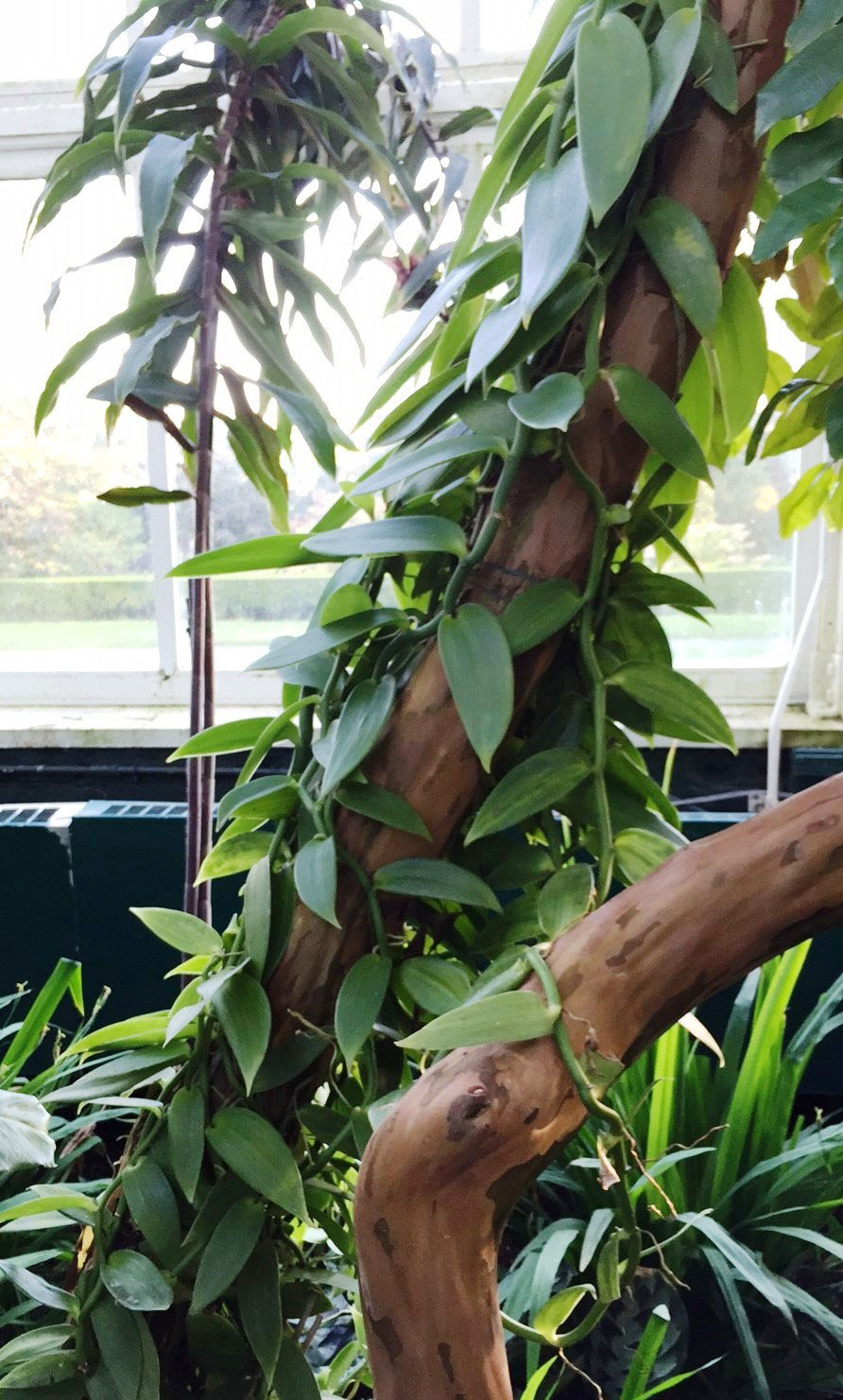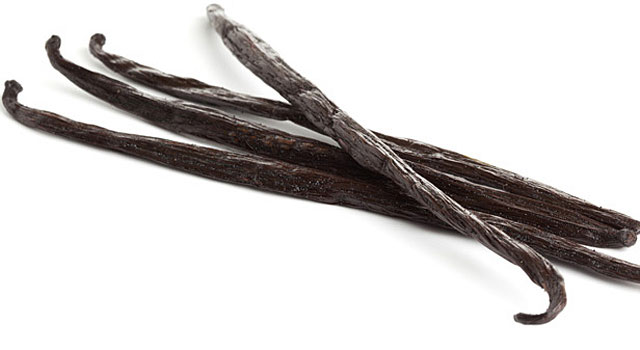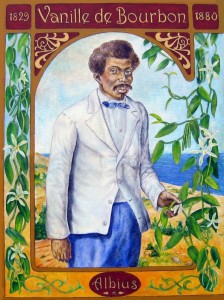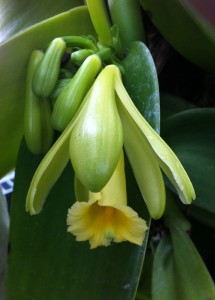Plain Vanilla, Rich History
Posted in Horticulture on March 31 2015, by Lansing Moore
Christian Primeau is the NYBG‘s Manager of the Enid A. Haupt Conservatory.
 Vanilla gets a bad rap. The term “vanilla” is bandied about to label all manner of the unexceptional, uninspiring or flat out boring. To my shock and dismay, a coworker recently applied this idiom to my beloved automobile. I’ll have you know, good sirs and madams, the 1988 Mercury Topaz has an abstruse appeal. Really, would I squander such an uproarious collection of bumper stickers on a so-called “boring” vehicle? FYI, the color isn’t beige…it’s called “Mojave Dune.” I mean, the factory only produced 300,000 units in Mojave Dune! You get the point. This is one sweet ride.
Vanilla gets a bad rap. The term “vanilla” is bandied about to label all manner of the unexceptional, uninspiring or flat out boring. To my shock and dismay, a coworker recently applied this idiom to my beloved automobile. I’ll have you know, good sirs and madams, the 1988 Mercury Topaz has an abstruse appeal. Really, would I squander such an uproarious collection of bumper stickers on a so-called “boring” vehicle? FYI, the color isn’t beige…it’s called “Mojave Dune.” I mean, the factory only produced 300,000 units in Mojave Dune! You get the point. This is one sweet ride.
Likewise, the vanilla orchid (Vanilla planifolia) itself is far from ordinary. In my humble opinion, Vanilla planifolia may be counted among the most fascinating plants in the Enid A. Haupt Conservatory. More than a flavoring for criminally overpriced lattes, it’s a beautiful vining orchid with a captivating history and makes a truly unique houseplant.

Like its culinary counterpart chocolate (derived from Theobroma cacao), vanilla was first discovered and cultivated by Pre-Colombian Mesoamericans. They dubbed it “Tlilxochitl” (pronounced tea-so-shill), or “Black Flower”. Far from describing the plant’s enchanting yellow-green to white blossom, the epithet refers to the intoxicatingly aromatic and delicious black seed pod that follows. The fruit, or “vanilla bean”, was coveted and commonly ground and mixed with wild honey or added to cacao-based beverages.
 In the early 1500s Spanish conquistador Hernán Cortés shipped a load or two of vanilla beans back to Spain. Vanilla quickly became a sensation among Europe’s elite. The late Aztec Emperor Moctezuma II would have the last laugh, though, as Europeans found it nearly impossible to achieve reliable pollination of their precious vanilla plants in the absence of a tiny bee species native only to Central and South America. No pollination, no vanilla beans. Not until 1819 would a 12 year old French slave from Réunion Island named Edmond Albius discover an efficient method of hand-pollinating the flower, thereby revolutionizing commercial vanilla production. Sadly, despite this invaluable contribution, Albius would die penniless. To this day his technique is employed at vanilla plantations around the globe.
In the early 1500s Spanish conquistador Hernán Cortés shipped a load or two of vanilla beans back to Spain. Vanilla quickly became a sensation among Europe’s elite. The late Aztec Emperor Moctezuma II would have the last laugh, though, as Europeans found it nearly impossible to achieve reliable pollination of their precious vanilla plants in the absence of a tiny bee species native only to Central and South America. No pollination, no vanilla beans. Not until 1819 would a 12 year old French slave from Réunion Island named Edmond Albius discover an efficient method of hand-pollinating the flower, thereby revolutionizing commercial vanilla production. Sadly, despite this invaluable contribution, Albius would die penniless. To this day his technique is employed at vanilla plantations around the globe.
 Unless we’re being literal, growing this orchid is anything but a vanilla experience. The plant will thrive in a well-drained, bark-based terrestrial orchid mix. When provided a trellis or support to clamber on and a little patience, the rewards of growing vanilla are tremendous. Your orchid won’t produce flowers until it has had a bit of time to mature, during which time you’ll need to provide it with adequate warmth (no lower than 60 degrees) and humidity, which can easily be maintained with a spray bottle, humidity tray, or my favorite option, relocation to a tropical setting with your plant in tow. Tahiti is a leading producer of vanilla and would certainly make a fine destination, but the plant is commercially cultivated throughout the Caribbean, South America, Madagascar, India and the Philippines. Like wine grapes, the unique soil composition and weather patterns of each region produces beans with very distinct flavor profiles. As with wine, connoisseurs develop personal flavor preferences. Exceptional vanilla commands a hefty price.
Unless we’re being literal, growing this orchid is anything but a vanilla experience. The plant will thrive in a well-drained, bark-based terrestrial orchid mix. When provided a trellis or support to clamber on and a little patience, the rewards of growing vanilla are tremendous. Your orchid won’t produce flowers until it has had a bit of time to mature, during which time you’ll need to provide it with adequate warmth (no lower than 60 degrees) and humidity, which can easily be maintained with a spray bottle, humidity tray, or my favorite option, relocation to a tropical setting with your plant in tow. Tahiti is a leading producer of vanilla and would certainly make a fine destination, but the plant is commercially cultivated throughout the Caribbean, South America, Madagascar, India and the Philippines. Like wine grapes, the unique soil composition and weather patterns of each region produces beans with very distinct flavor profiles. As with wine, connoisseurs develop personal flavor preferences. Exceptional vanilla commands a hefty price.
Today anyone may grow this beautiful and historically relevant plant in their own home without having to endure the guilt and hazard of conquering a sprawling Central American empire. A quick online search will yield a number of inexpensive sources for Vanilla planifolia (there is even an extraordinarily beautiful variegated form). If you’re looking for something out of the ordinary to grow, give it a try. Good luck—perhaps I’ll see you in Tahiti. As always, if you can’t sneak off to a tropical locale, experience the beauty of the tropics under glass right here at the historic Enid A. Haupt Conservatory. Find Vanilla planifolia and thousands of other breathtaking exotic orchids in the jaw-dropping Orchid Show, open now through April 19. Keep an eye out for me—I’ll be the guy with the big smile and the really cool car.

